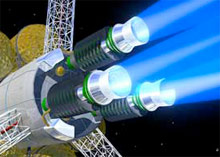Nasa will soon announce plans to test a revolutionary new drive system aboard the International Space Station. The propulsion tech in question is a plasma engine known as Variable Specific Impulse Magnetoplasma Rocket (VASIMR).
According to Flight International, NASA supremo Michael Griffin says that his agency is "at the end stages of agreeing a co-operative agreement for NASA to test the VASIMR engine on station".
The plasma drive is intended to work by using electric power to blast hydrogen reaction mass from its rocket nozzles at a much greater velocity than normal chemically-fuelled rockets can achieve. This means that the carrying spacecraft gets a lot more acceleration or deceleration from a given amount of fuel, and so can potentially make interplanetary journeys in much shorter times. Another potential application seen for VASIMR is maintenance of the space station's orbit, without the need to burn off colossal amounts of chemical rocket fuel.
VASIMR is the brainchild of Franklin Chang-Díaz, MIT plasma physicist and former NASA astronaut with seven Shuttle flights and 1600 hours in space. Chang-Díaz nowadays heads up the Ad Astra Rocket Company, dedicated to bringing plasma drives to market. He believes that VASIMR - or some kind of more fuel-efficient propulsion, anyway - must be developed, or travel beyond Earth orbit will never become a serious activity.
In the near future, for lower-thrust applications at Earth orbit or closer to the sun, plasma drives could draw their power from solar panels - the mainstream means of electricity generation in spacecraft today. The proposed ISS orbit-maintenance plan would be on this model. But more ambitious uses for the electric rockets, such as carrying humans on fast interplanetary journeys*, would require higher output, probably from onboard nuclear powerplants.

